By my count they totaled only six, and they enjoyed only one full decade of business, but they served as a bridge between where we had shopped in the past and where we would shop in the future.
To the consumer of sixty years ago it might have seemed that shopping just could not get any better. After all, there were major department stores—Leonard’s, Monnig’s, Stripling’s—downtown. There were dime stores—Kress, W. T. Grant, F. W. Woolworth, H. L. Green, and McCrory’s—downtown. In the neighborhoods there were more dime stores: Mott’s, S. S. Kresge, M. E. Moses, T. G. & Y., Ben Franklin. A few downtown department stores—such as The Fair and R. E. Cox—even had opened suburban branch stores in the 1950s.
But two concepts would change the way we shop. One was the shopping mall. In 1962 Seminary South opened as Fort Worth’s first shopping mall.
But the first of the two concepts came three years before Seminary South: the first of Fort Worth’s big-box discount department stores. Store of this new breed (1) were part of a chain, (2) were located in neighborhoods (not downtown), and (3) combined the merchandise of a downtown department store with the lower prices of a neighborhood dime store. (Imagine a love child born of Leonard’s and Mott’s.)
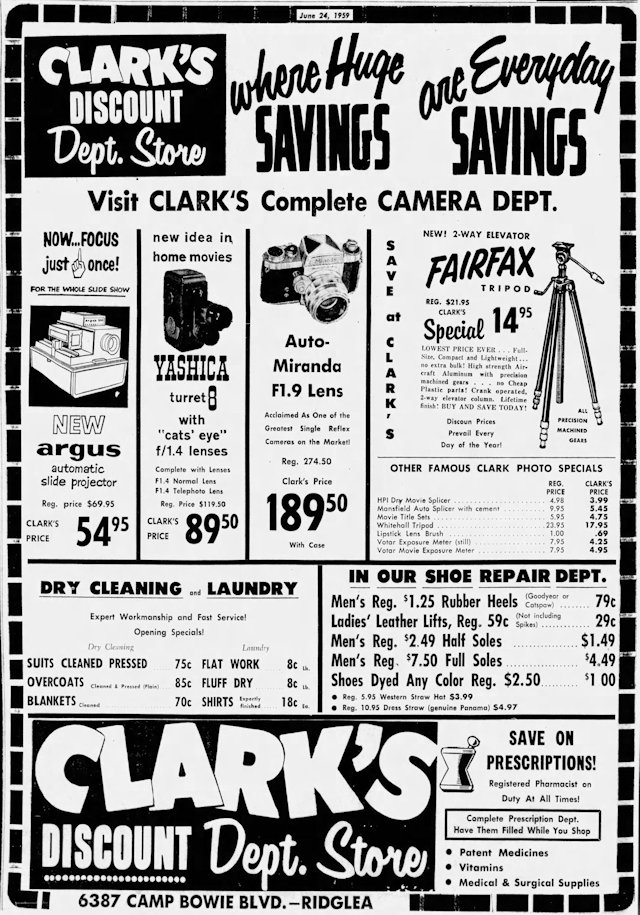 Fort Worth’s first big box was Clark’s Discount Store No. 1, which opened June 25, 1959 in Ridglea Plaza on Camp Bowie Boulevard. Note that the store had a shoe repair department, a pharmacy, and a dry cleaning and laundry service.
Fort Worth’s first big box was Clark’s Discount Store No. 1, which opened June 25, 1959 in Ridglea Plaza on Camp Bowie Boulevard. Note that the store had a shoe repair department, a pharmacy, and a dry cleaning and laundry service.
The Clark company was an eastern department store chain that had been in business since 1912. The Fort Worth store was the chain’s twenty-eighth.
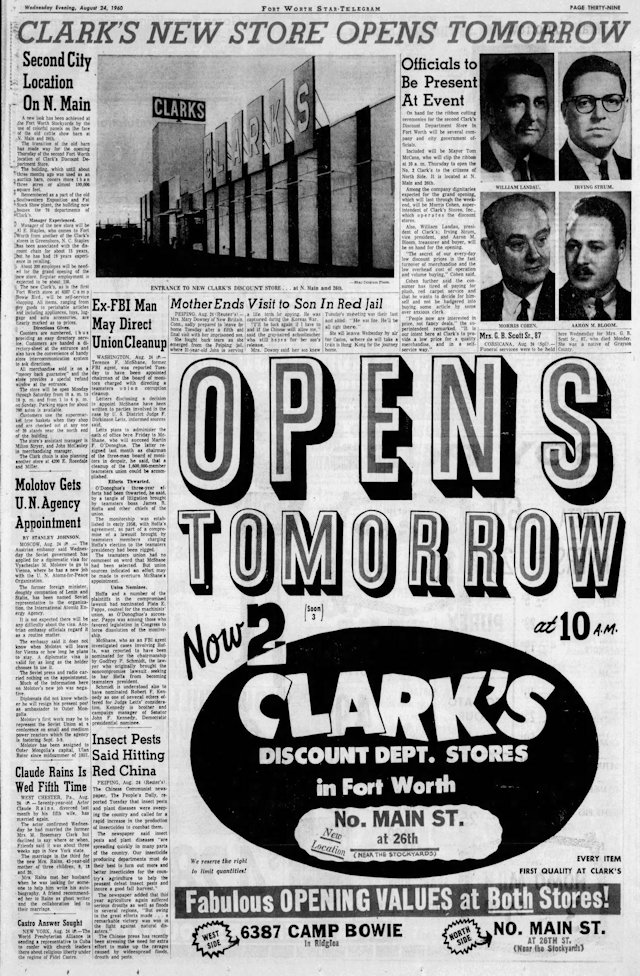 Clark’s second Fort Worth store, which opened in 1960, was housed in a huge building in the stockyards. With three acres of floor space, Clark’s No. 2 was so big that the stock boys covered the vastness on roller skates. The building had opened in 1910 as an open-air livestock barn (with a sloping floor for easier cleaning). In 1936 the building was enclosed by the city and used to house cattle for the stock show. Livestock events were held in the building until the stock show moved to Will Rogers Memorial Complex in 1944.
Clark’s second Fort Worth store, which opened in 1960, was housed in a huge building in the stockyards. With three acres of floor space, Clark’s No. 2 was so big that the stock boys covered the vastness on roller skates. The building had opened in 1910 as an open-air livestock barn (with a sloping floor for easier cleaning). In 1936 the building was enclosed by the city and used to house cattle for the stock show. Livestock events were held in the building until the stock show moved to Will Rogers Memorial Complex in 1944.
During the last part of World War II the Clark’s building housed Globe Aircraft Corporation, which built AT-10 trainer airplanes.
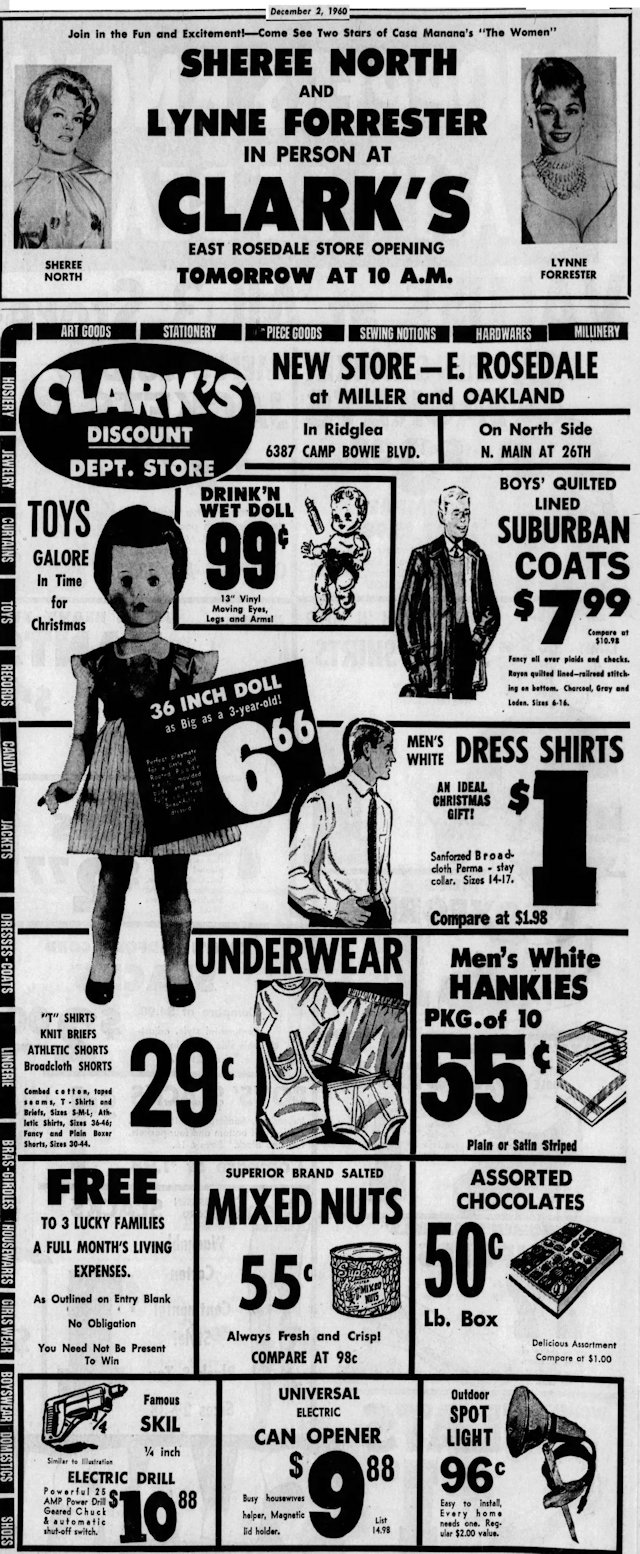 Clark’s third store opened on East Rosedale Street in 1960. Note that appearing at the grand opening was future Emmy-nominated actress Sheree North, in town for a show at Casa Manana.
Clark’s third store opened on East Rosedale Street in 1960. Note that appearing at the grand opening was future Emmy-nominated actress Sheree North, in town for a show at Casa Manana.
 Three big-box discount department stores opened in Fort Worth in 1960. And on July 17 the Star-Telegram announced in a front page story that the Atlantic Mills company would build a “thrift department store” on South Beach Street in Poly.
Three big-box discount department stores opened in Fort Worth in 1960. And on July 17 the Star-Telegram announced in a front page story that the Atlantic Mills company would build a “thrift department store” on South Beach Street in Poly.
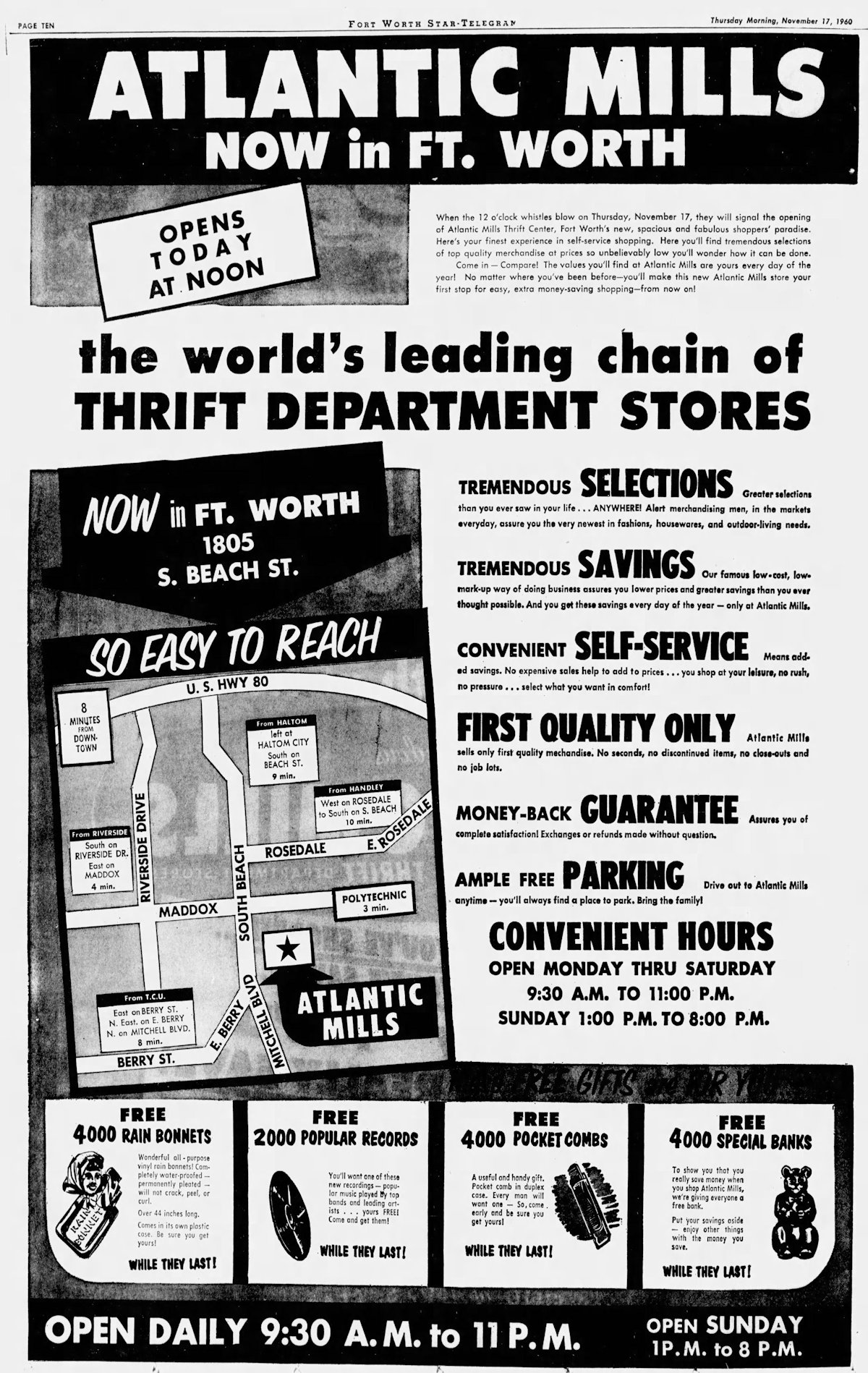 That store opened in November.
That store opened in November.

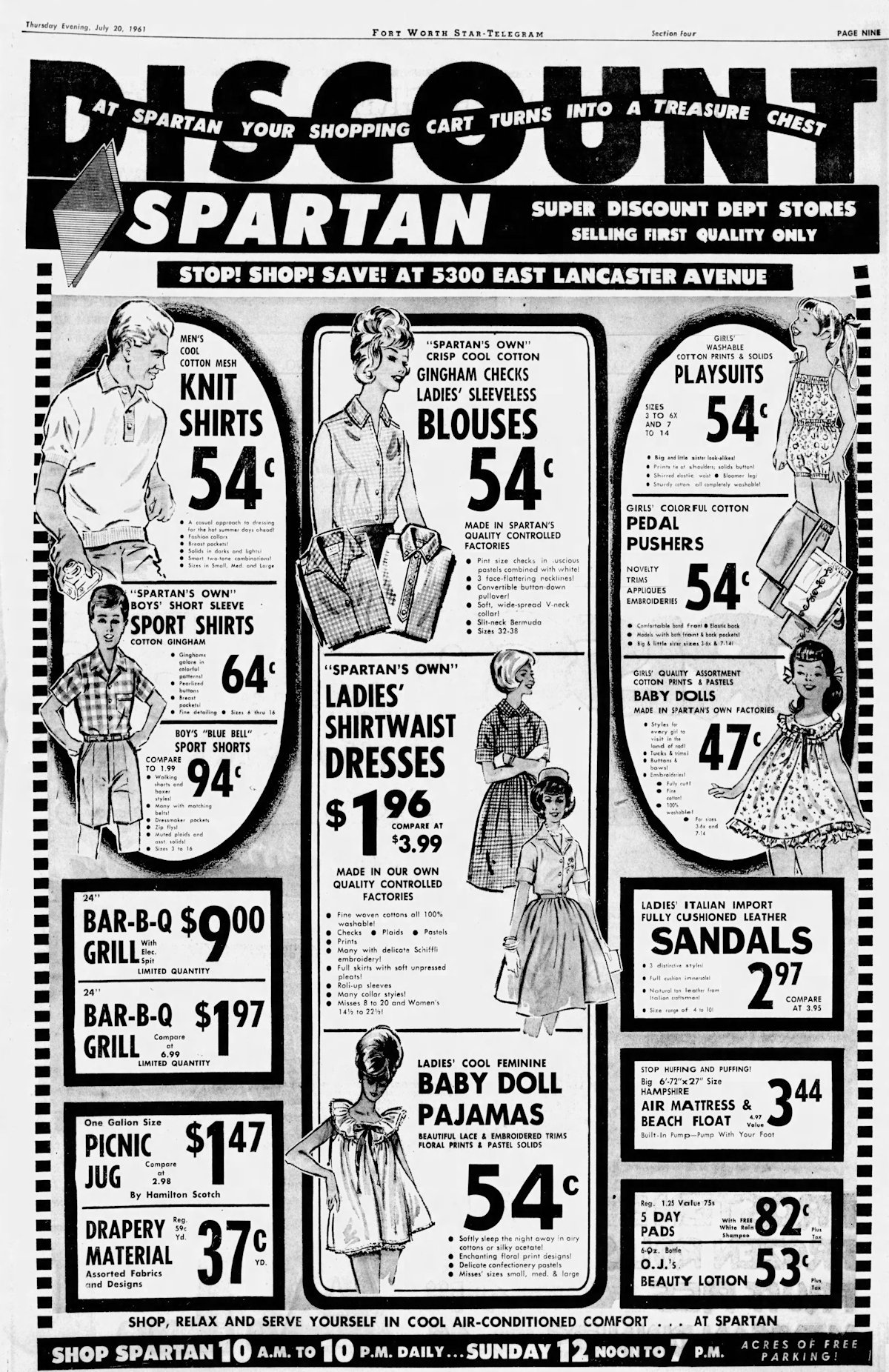 The next year, 1961, Fort Worth’s fifth big-box discount department store, Spartan, opened on East Lancaster Avenue.
The next year, 1961, Fort Worth’s fifth big-box discount department store, Spartan, opened on East Lancaster Avenue.
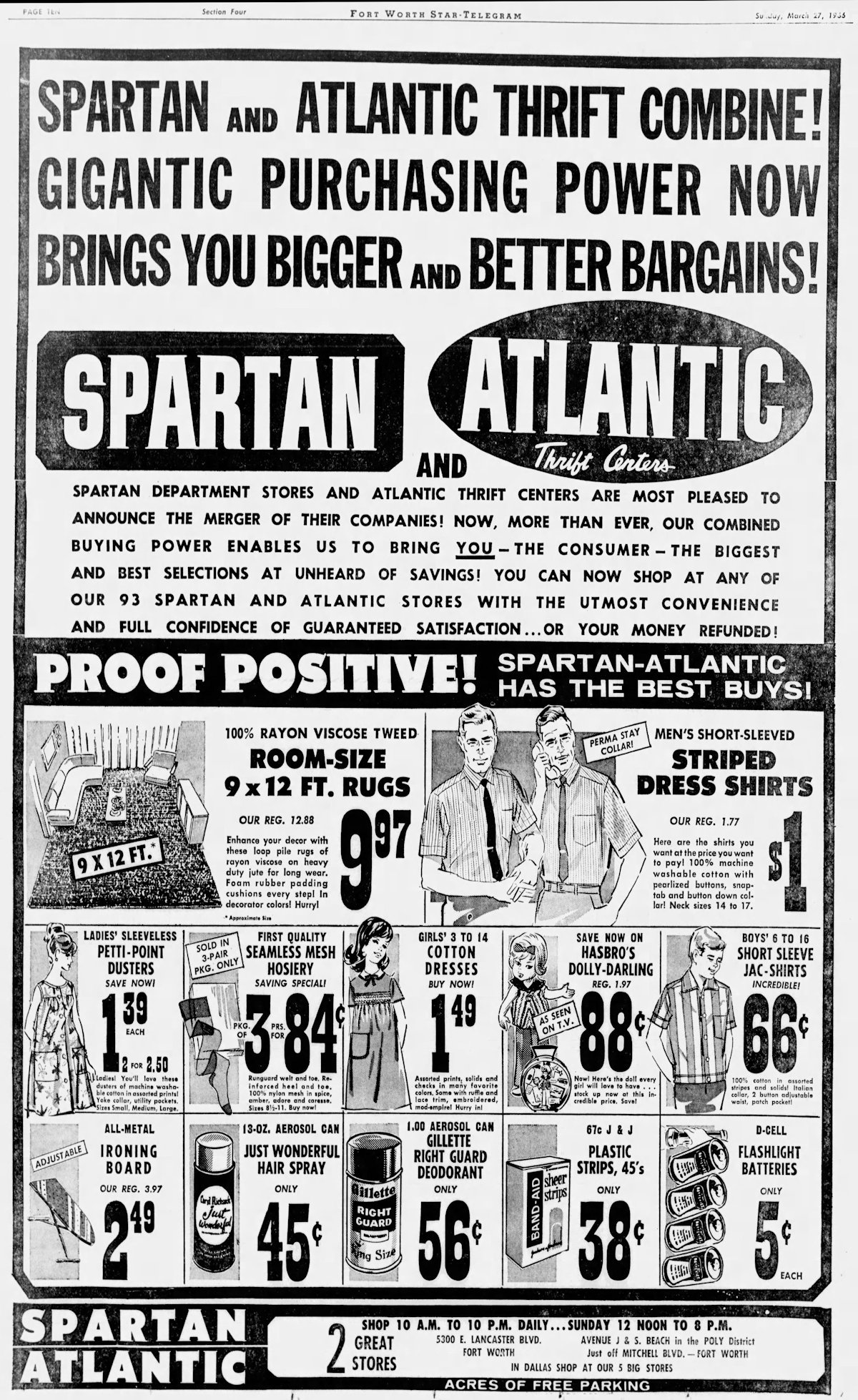 In 1966 the Atlantic Mills and Spartan companies merged to become Spartan-Atlantic. The company operated ninety-three stores nationwide.
In 1966 the Atlantic Mills and Spartan companies merged to become Spartan-Atlantic. The company operated ninety-three stores nationwide.
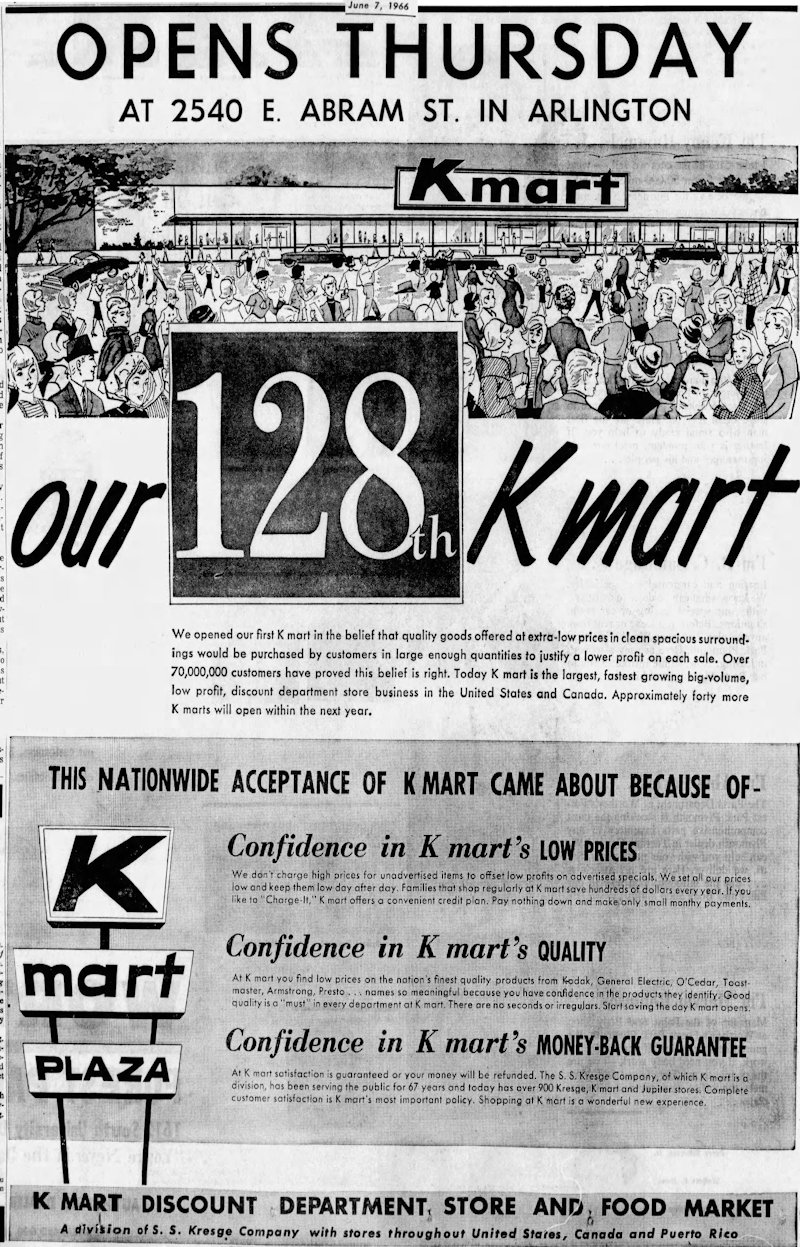 Also in 1966 the hearts of local shoppers first thrilled to the announcement of a “Blue Light Special” as the first Kmart store opened in Arlington. At its peak in 1994 the Kmart company operated 2,323 stores in the United States. Fewer than ten remain.
Also in 1966 the hearts of local shoppers first thrilled to the announcement of a “Blue Light Special” as the first Kmart store opened in Arlington. At its peak in 1994 the Kmart company operated 2,323 stores in the United States. Fewer than ten remain.
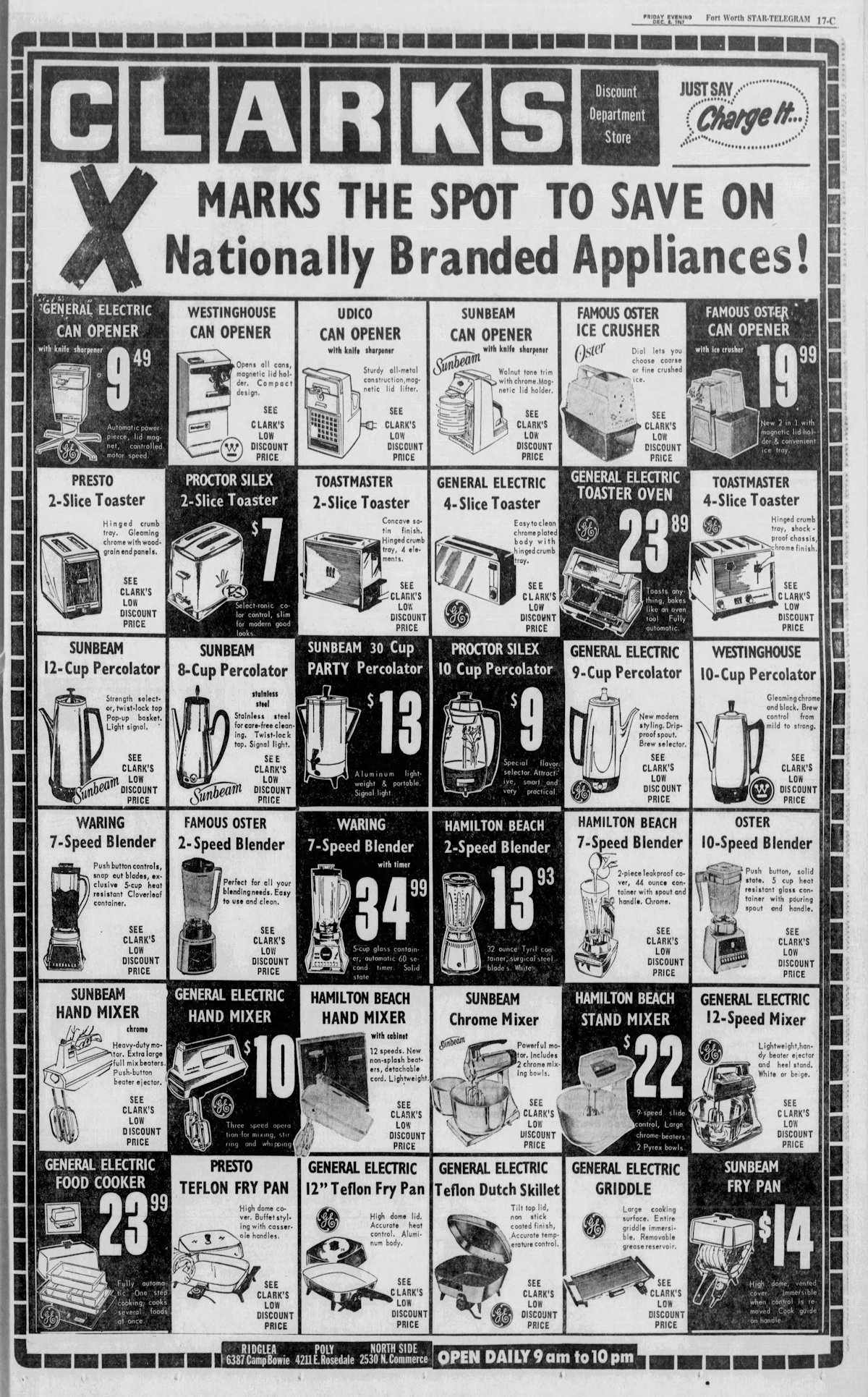
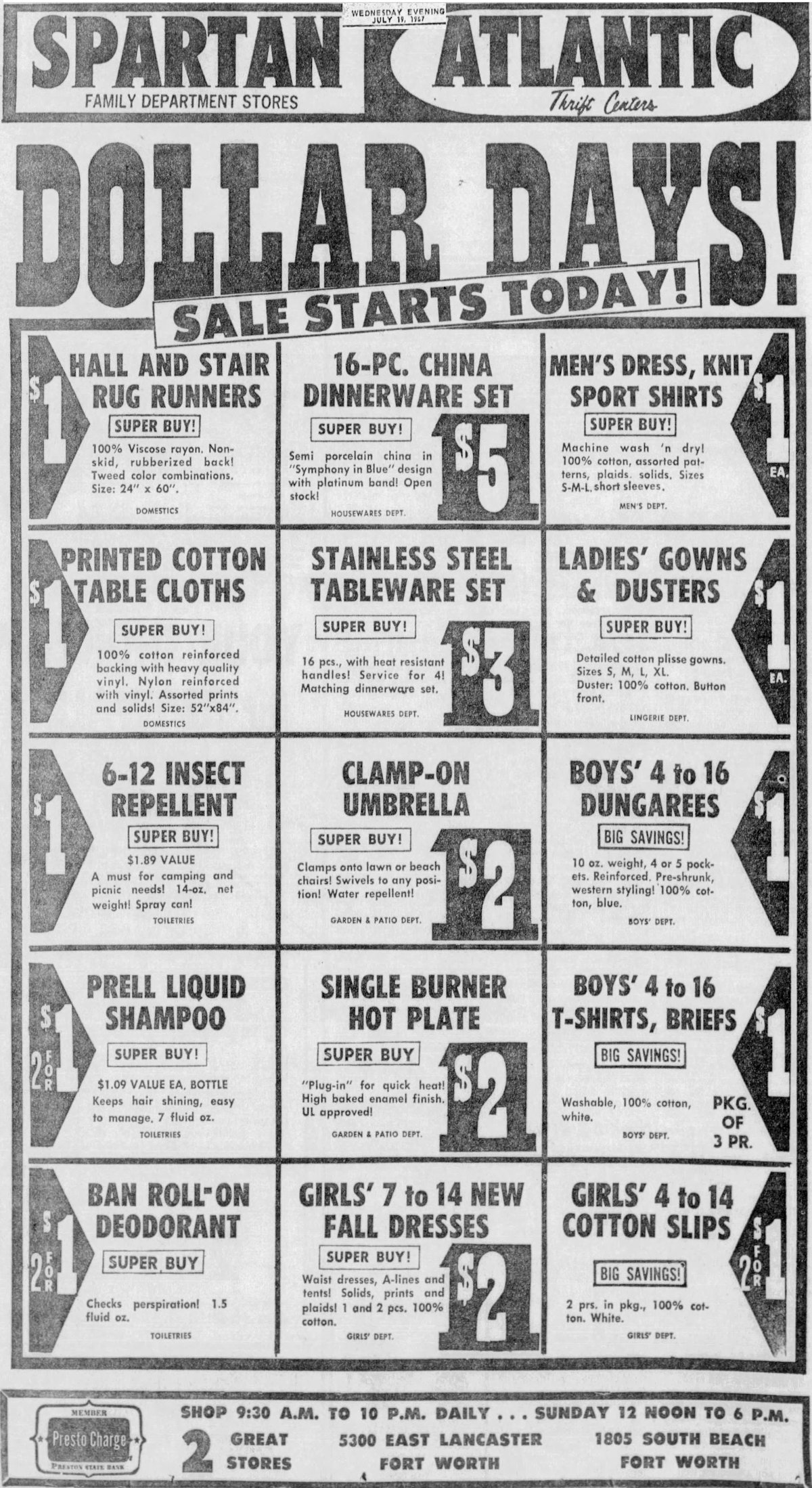 Fast-forward to 1967. Clark’s still had just three stores. Spartan-Atlantic still had just two stores.
Fast-forward to 1967. Clark’s still had just three stores. Spartan-Atlantic still had just two stores.
In their advertising these first big-box discount department stores stressed three features: self-service, discount prices, and plenty of free parking.
The Star-Telegram wrote: “The operations of the stores . . . is similar to that of supermarkets. Customers are provided shopping carts for their self-service selections and pay for their purchase at one of the checkout counters.”
These stores had one other feature that would prove controversial:
 They were open seven days a week. That means Sundays. That was simply not done sixty years ago. Being able to shop seven days a week may have pleased consumers, but some church groups shouted “Unholy!” and some merchants shouted “Unfair!”
They were open seven days a week. That means Sundays. That was simply not done sixty years ago. Being able to shop seven days a week may have pleased consumers, but some church groups shouted “Unholy!” and some merchants shouted “Unfair!”
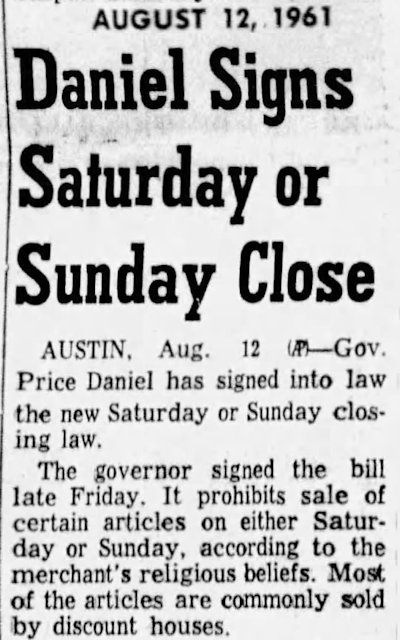 The state legislature had responded in 1961 by passing a blue law, which was aimed at the then-new big-box discount department stores. By that law merchants could not sell forty-two categories of items on consecutive Saturdays and Sundays. Shoppers could sign a form claiming an emergency in order to be allowed to buy any of the forty-two forbidden fruits.
The state legislature had responded in 1961 by passing a blue law, which was aimed at the then-new big-box discount department stores. By that law merchants could not sell forty-two categories of items on consecutive Saturdays and Sundays. Shoppers could sign a form claiming an emergency in order to be allowed to buy any of the forty-two forbidden fruits.
Among the items that could not be sold on consecutive Saturdays and Sundays were clothing, clothing accessories, wearing apparel, footwear, headwear, kitchen utensils, china, home appliances, stoves, refrigerators, air-conditioners, electric fans, radios, television sets, washing machines, driers, jewelry, precious or semiprecious stones, silverware, watches, clocks, luggage, motor vehicles, musical instruments, and toys (excluding items customarily sold as novelties and souvenirs).
The blue law was, in effect, a Sunday closing law. Why would merchants bother to open on a day when they could not sell most of their merchandise?
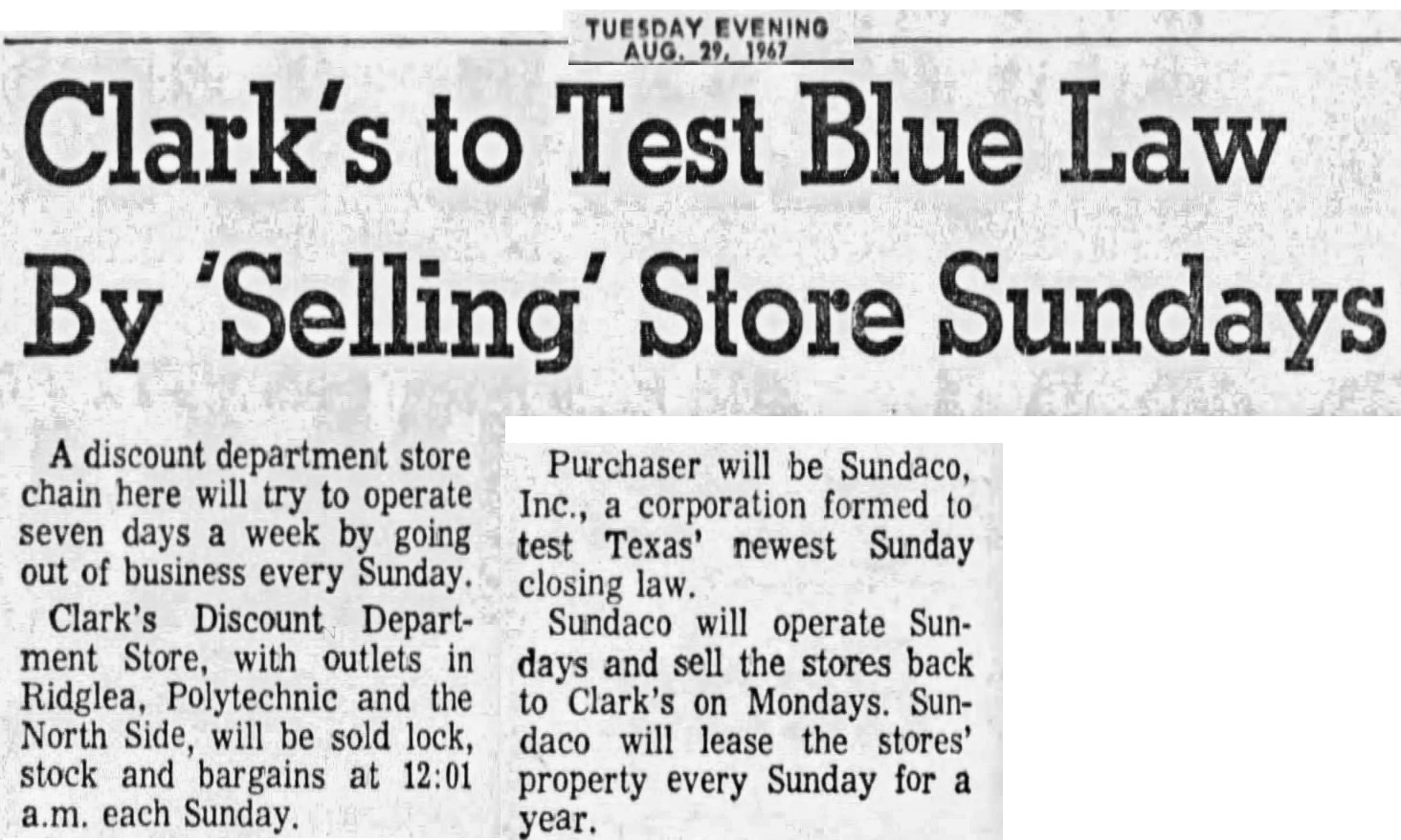 In 1967 the state made the blue law even more restrictive: Customers could no longer sign a form claiming an emergency in order buy the forty-two forbidden fruits. The Clark’s company found a way to skirt the law and keep its stores open on Sunday: At one minute past midnight each Sunday morning the Clark’s company sold its stock and leased its buildings to Sundaco, a new corporation formed to test the blue law. On Monday mornings Sundaco sold the stock back to Clark’s.
In 1967 the state made the blue law even more restrictive: Customers could no longer sign a form claiming an emergency in order buy the forty-two forbidden fruits. The Clark’s company found a way to skirt the law and keep its stores open on Sunday: At one minute past midnight each Sunday morning the Clark’s company sold its stock and leased its buildings to Sundaco, a new corporation formed to test the blue law. On Monday mornings Sundaco sold the stock back to Clark’s.
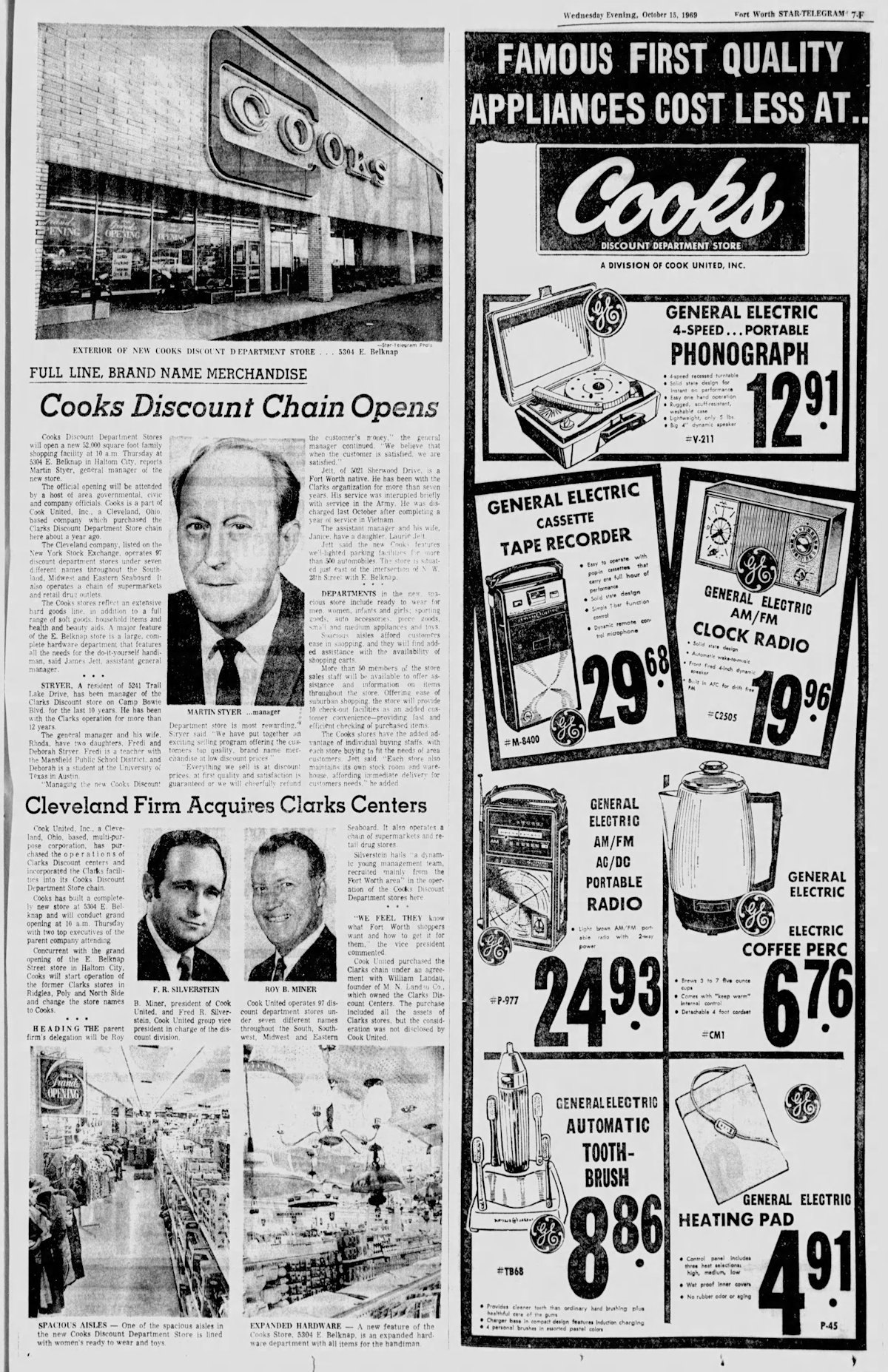 In 1969 the Clark’s stores were sold to the Cook discount store chain. The Cook company opened a fourth store on East Belknap Street.
In 1969 the Clark’s stores were sold to the Cook discount store chain. The Cook company opened a fourth store on East Belknap Street.
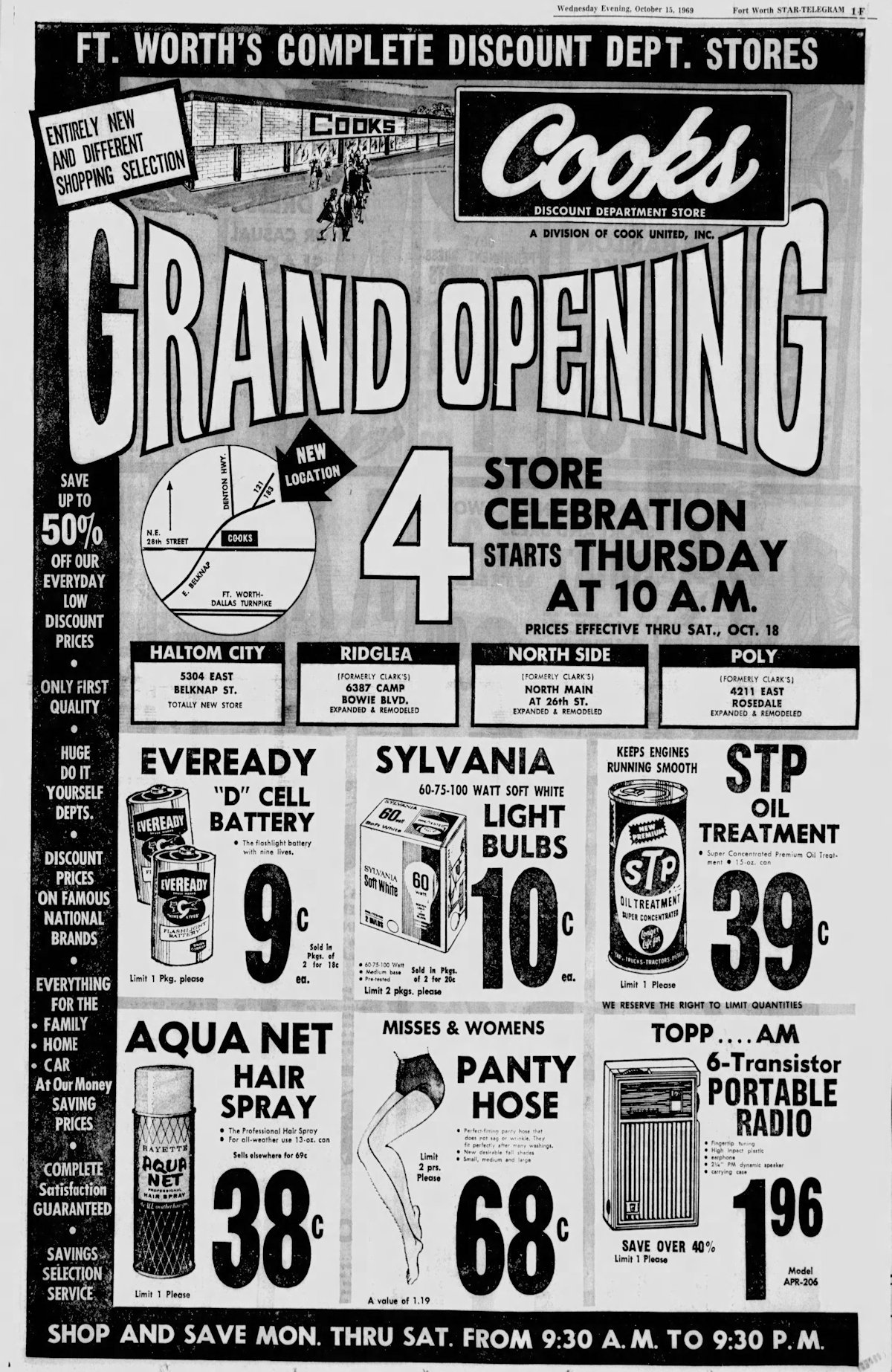
After the Clark’s stores became Cook’s stores, the Cook company continued to lease its stores to Sundaco on Sundays. In this ad for the grand opening of the new Cook’s store, notice the “Shop and Save Mon. Thru Sat.” Technically Sundaco—not Cook’s—was open on Sundays.
 By December 1969 the state’s blue law had been ruled constitutional, and a judge had issued a restraining order forbidding Cook’s/Sundaco to open on consecutive Saturdays and Sundays. But in a court hearing a district attorney’s office investigator testified that, to gather “evidence,” on three weekends he had bought men’s shirts at a Cook’s/Sundaco store on consecutive Saturdays and Sundays.
By December 1969 the state’s blue law had been ruled constitutional, and a judge had issued a restraining order forbidding Cook’s/Sundaco to open on consecutive Saturdays and Sundays. But in a court hearing a district attorney’s office investigator testified that, to gather “evidence,” on three weekends he had bought men’s shirts at a Cook’s/Sundaco store on consecutive Saturdays and Sundays.
Cases challenging and defending Texas’s blue law would drag through the court system until 1985.
 That’s when Texas would gut the blue law, retaining only the restriction on the Sunday sale of automobiles. In 1985 the state also would make seat belt use mandatory.
That’s when Texas would gut the blue law, retaining only the restriction on the Sunday sale of automobiles. In 1985 the state also would make seat belt use mandatory.
Repealing the blue law was too little too late for Fort Worth’s first big-box discount department stores. The 1970s had already hung the “Closed” sign on their front doors. The Cook’s stores closed in 1974. The next year a Handy Dan home improvement center moved into Cook’s store No. 1 on Camp Bowie Boulevard.
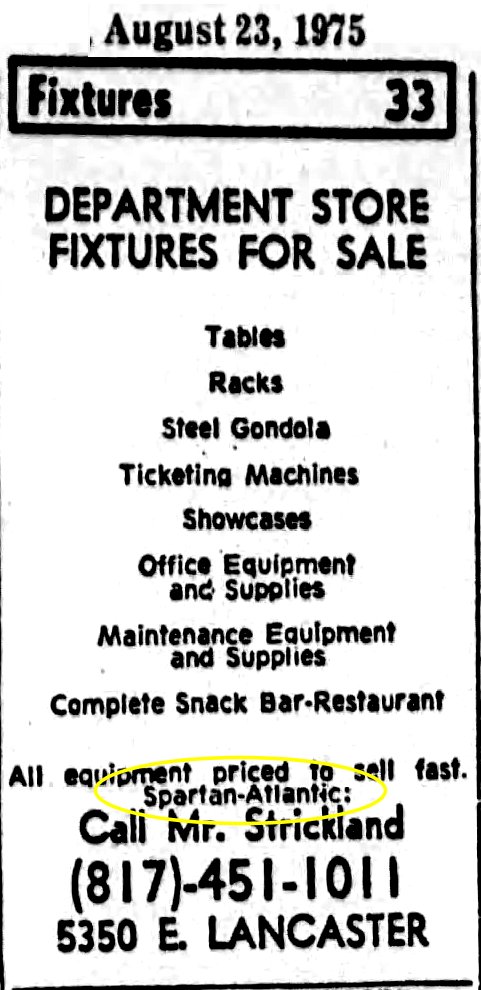 In 1975 the Spartan-Atlantic store on East Lancaster Avenue closed, its fixtures sold like bric-a-brac at an estate sale. In 1978 the building became a Kmart store.
In 1975 the Spartan-Atlantic store on East Lancaster Avenue closed, its fixtures sold like bric-a-brac at an estate sale. In 1978 the building became a Kmart store.
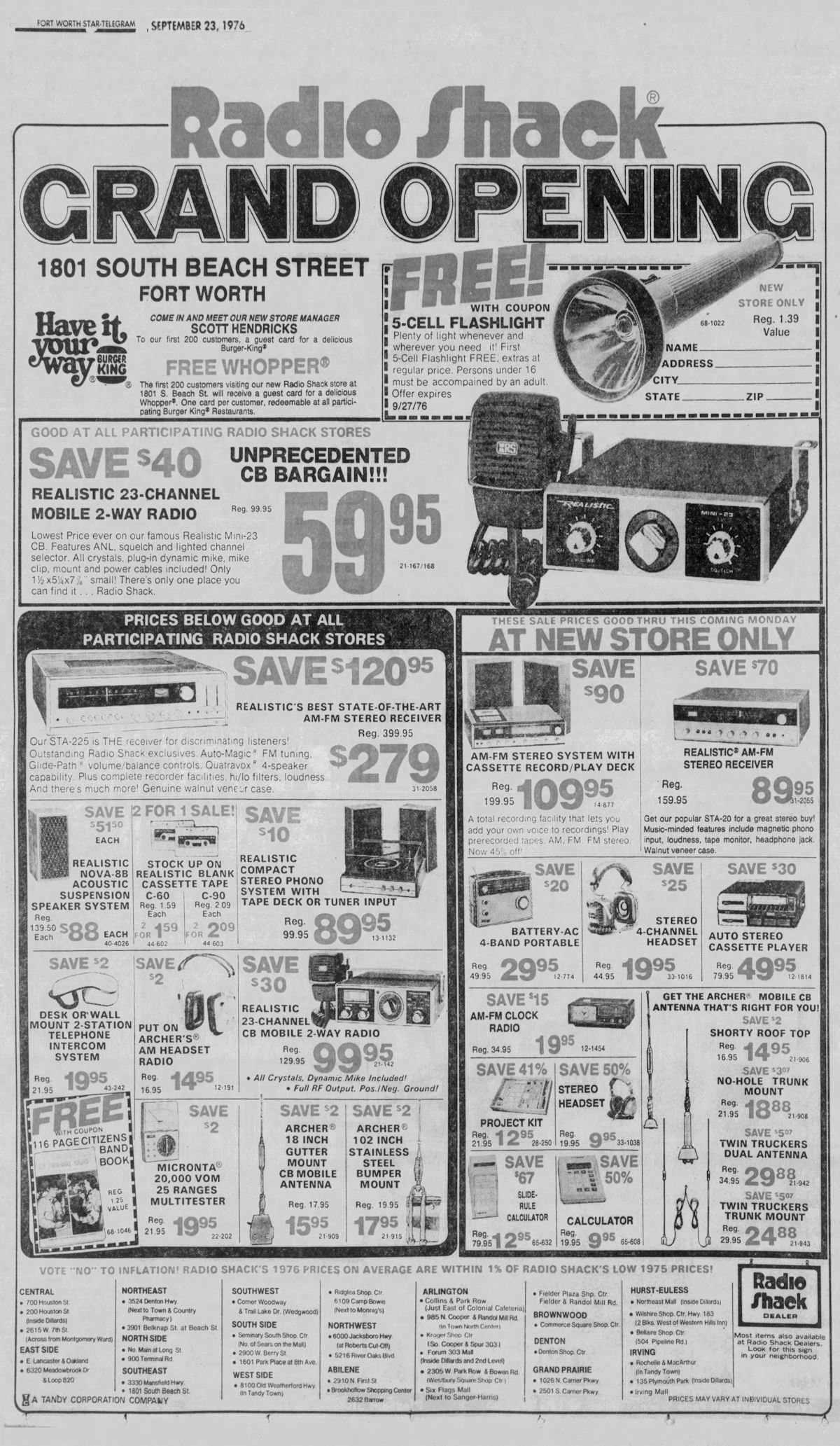 In 1976 the Atlantic Mills/Spartan-Atlantic building on Beach Street became a Radio Shack store.
In 1976 the Atlantic Mills/Spartan-Atlantic building on Beach Street became a Radio Shack store.
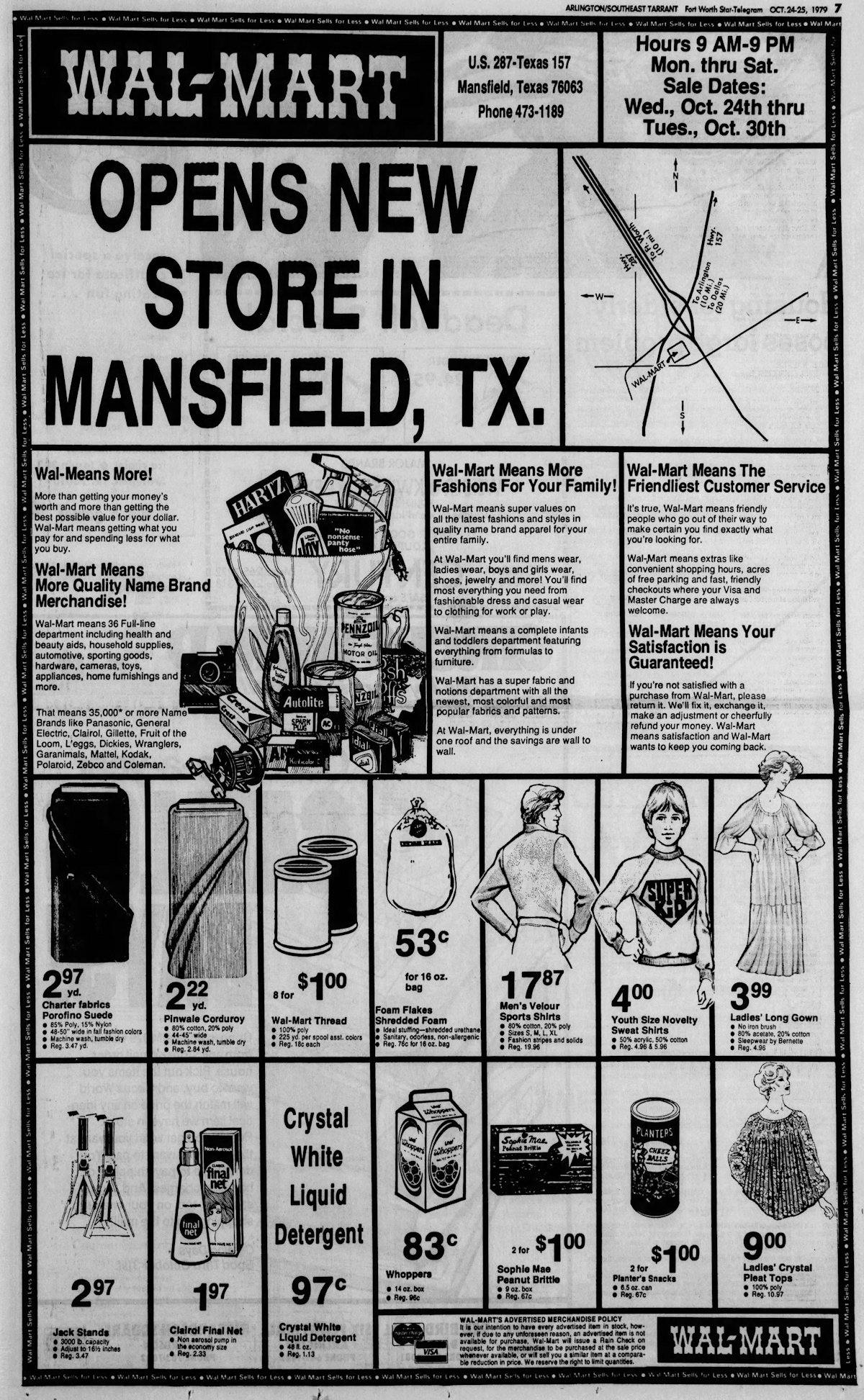 Yes, Fort Worth’s first big-box discount department stores are gone, but their big-box discount concept lived on. Fast-forward to 1979. That thundering that north Texans heard on the horizon was the footsteps of Sam Walton, bringing his Walmart chain to the area. The first store opened in Mansfield in October.
Yes, Fort Worth’s first big-box discount department stores are gone, but their big-box discount concept lived on. Fast-forward to 1979. That thundering that north Texans heard on the horizon was the footsteps of Sam Walton, bringing his Walmart chain to the area. The first store opened in Mansfield in October.
Today what remains of those six first big boxes? The Clark’s/Cook’s No. 1 building on Camp Bowie Boulevard apparently was torn down in the 1980s. A Tom Thumb and Stein Mart stand there today. And the Clark’s/Cook’s No. 3 building on East Rosedale Street was torn down between 2004 and 2007.
But four of the six buildings survive.
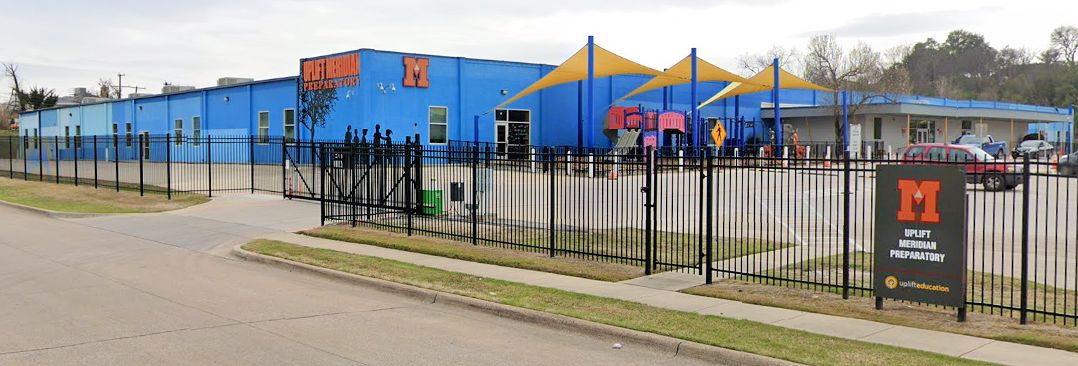 In 2012 Uplift Meridian Preparatory School moved into the Atlantic Mills/Spartan-Atlantic building on Beach Street. The Uplift Education company also operates Uplift Mighty Preparatory School on the former Masonic Home campus.
In 2012 Uplift Meridian Preparatory School moved into the Atlantic Mills/Spartan-Atlantic building on Beach Street. The Uplift Education company also operates Uplift Mighty Preparatory School on the former Masonic Home campus.
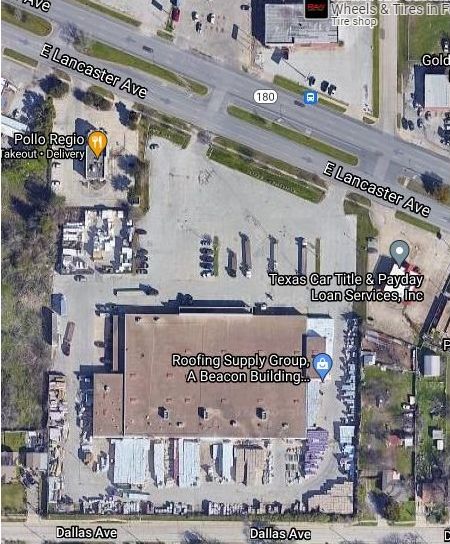 The Spartan/Spartan-Atlantic building on East Lancaster Avenue now houses a roofing supply company.
The Spartan/Spartan-Atlantic building on East Lancaster Avenue now houses a roofing supply company.
 The Clark’s/Cook’s No. 4 building on East Belknap Street now houses the Birdville school district’s Council of PTA’s Clothes Connection.
The Clark’s/Cook’s No. 4 building on East Belknap Street now houses the Birdville school district’s Council of PTA’s Clothes Connection.
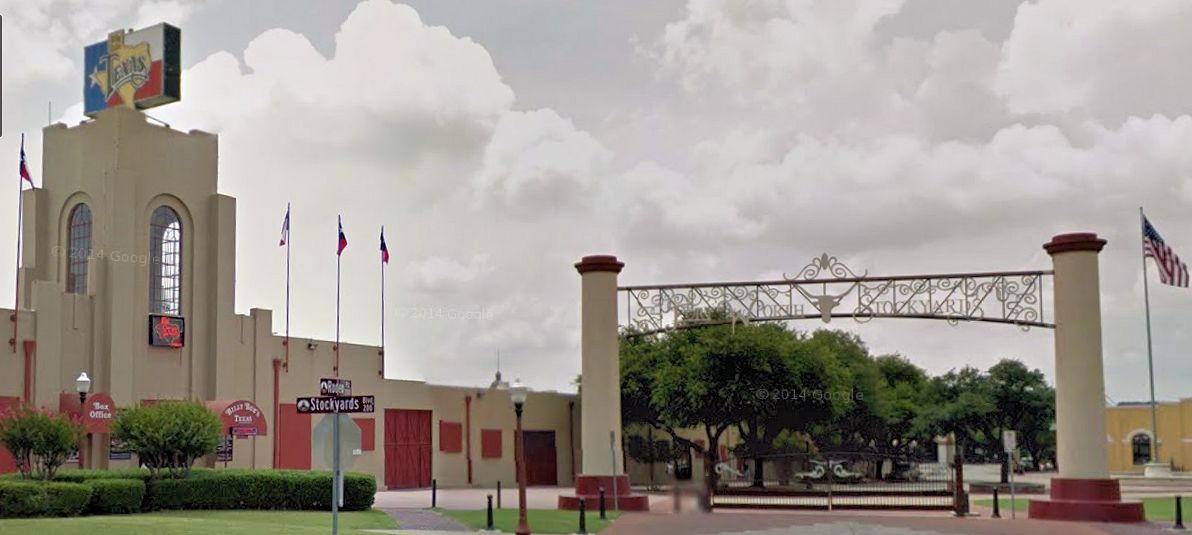 And in the Clark’s/Cook’s No. 2 building at the stockyards, where once stock boys roller-skated, today couples two-step: On April 2, 1981 Billy Bob’s Texas opened in the former cattle barn/aircraft factory/discount store building.
And in the Clark’s/Cook’s No. 2 building at the stockyards, where once stock boys roller-skated, today couples two-step: On April 2, 1981 Billy Bob’s Texas opened in the former cattle barn/aircraft factory/discount store building.
Yes, Fort Worth’s original big-box discount department stores are gone. But their descendants thrive. For now. Fifty, seventy-five years from now, what will today’s Walmart buildings house?






You left out the fact that between the aircraft plant and Clark’s in the stockyards, the space was occupied by a Dumas Milner Chevrolet dealership
(after Frank Kent decided to specialize in Cadillac). Dumas Milner also owned Pine-Sol cleaner.
You neglected to mention that between the aircraft plant and Clark’s the building was for some years the home of a Dumas Milner Chevrolet dealership
(after Frank Kent changed from Chevrolet to Cadillac). Dumas Milner also owned Pine-Sol.
… Unrelated social commentary…
… When I first moved to “the fort” Mrs Nina Todd would spend hours telling me all about the history of her home place and it’s people…
… My absolute favorite saying of hers, that I can still hear to this day, in her “De-ca-tur drawl” … “Anybody who is anybody has been through Fort Worth, if you ain’t been to Fort worth maybe you ain’t as important as you think you are”…
… The ultimate “bless your heart”…
LOL. I had never heard that one before. Somewhere Amon is smiling. Thanks.
… I love retail, I got excited just reading the articles about the new Spartan store on Lancaster and all the “new” innovations they were bringing to retail, good times… … Do you know much about our own Charles Tandy and the Tandy Corp…
… At one time they were all over the retail map with Tandy leather, Pier one, Radio shack, Tandy transportation and my alumni Color tile (the original DIY before it was called DIY) and all this was headquartered out of our little downtown Fort worth…
… I truly believe this would be a Worth(y) subject of your historcal prowess…
… I love retail…
Don’t know much about Charles except that he apparently was not closely related to the Poly Tandys. I’ll tackle Charles one of these days. Some subjects are so big that they overwhelm me, and I don’t know where to get a toehold. That’s why I put off Amon for years.
i got a free rain cap at atlantic mills.got the 5 cell flass ligt at radil shack.what was the aircraft co at billy boobs?great work mike.
Thanks, Orville. The aircraft company was John Kennedy’s Globe Aircraft.
Oh, the prices back then!! It’s funny how once they are no longer in business, they slip from our thoughts. Out of sight, out of mind. It takes a history buff to jog those memories back out again. Thank you.
Thanks, Katherine. Three of those stores were on the East Side, where I grew up, and my family shopped at all three. I remember that record albums were $2.99 (stereo) and $1.99 (monaural). I bought the Beatles. My mother bought classical. My father bought bluegrass.